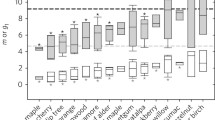Abstract
Stomata govern carbon-water balance by simultaneously controlling photosynthesis (A) and transpiration (E). It is unclear how patchy stomatal conductance influences this control. Cowan and Farquhar showed that for a given water supply available during a fixed time interval, carbon gain is maximized by a pattern of stomatal behavior that keeps the partial derivative of A with respect to E constant. This result implies that spatially uniform stomatal conductance is optimal (provided photosynthetic performance and environmental conditions are spatially uniform), so patchy stomatal conductance should be detrimental to carbon-water balance. However, these results required that the curvature of A versus E be uniformly negative. Using mathematical arguments and computer modeling, we show that (1) this caveat is violated under some environmental conditions, (2) water-use efficiency (A/E) is nearly unaffected, and can actually be improved, by patchiness under these conditions, and (3) patchiness has most often been observed under conditions similar to these. These results imply that under many conditions, patchiness may not significantly influence carbon-water balance, consistent with recent work suggesting patchiness may be common but unobserved. Additionally, we discuss implications of these results that muddle the definition of `optimal' in the context of plant gas exchange in some situations, and extend the work of Cowan and Farquhar under conditions causing positive curvature in A versus E.
Similar content being viewed by others
Author information
Authors and Affiliations
Additional information
Received: 15 May 1998 / Accepted: 14 October 1998
Rights and permissions
About this article
Cite this article
Buckley, T., Farquhar, G. & Mott, K. Carbon-water balance and patchy stomatal conductance. Oecologia 118, 132–143 (1999). https://doi.org/10.1007/s004420050711
Issue Date:
DOI: https://doi.org/10.1007/s004420050711




